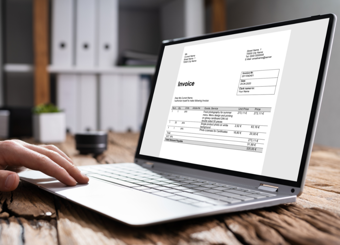What Are Accounts Payable vs. Receivable Best Practices?
Organizations must maintain control over accounts payable and accounts receivable best practices to build a healthy and profitable business. Accounts payable refers to the money an organization owes, while accounts receivable is the money owed to the company.
Both AP and AR are crucial to the overall success of any operation. From timely production to increasing annual profits, the monies coming in and out of the business require constant monitoring. Discover the role automation plays in streamlining operations and maintaining accounts payable and accounts receivable best practices.
What are the biggest differences between accounts receivable and accounts payable?
Analyzing accounts payable and accounts receivable is critical for proper cash flow management. First, consider how organizations do business. The initial step is purchasing essential supplies for production and distribution. Accounts payable lists an organization’s short-term liabilities for items purchased from suppliers and money owed to creditors.
Conversely, accounts receivable refers to the money an organization expects to receive from customers and partners. With that in mind, accounts receivable are listed as assets on the balance sheet, while accounts payable are liabilities. Cloud automation brings your team together in real-time from any location to stay on top of AP and AR analytics - and make money-altering decisions accordingly.
What is a good strategy in managing accounts payable?
Effective strategies in managing accounts payable help reduce costs and eliminate fraud. For example, decreasing the cost per invoice helps companies save money. As a result, management realizes a measurable return on investment for adopting AP automation solutions. Plus, automation reduces invoice processing time to help organizations negotiate discounts from suppliers for early payments, improving supplier relationships and production.
Automation provides superior transparency and visibility with customized access to help eliminate errors and fraud. In addition, cloud automation supports remote work to avoid business interruptions. As a result, the AP team emerges from the back office for intelligent work, such as finding ways to reduce interest on credit and eliminate late fees for late payments. Another way automation cuts costs are by keeping up with subscriptions and automatic payments to avoid interruptions and late fees.
What are some accounts receivable best practices?
Accounts receivable best practices ensure organizations properly manage cash flow and remain profitable. Automation provides access to ongoing analytics to help management make important decisions when they matter most. The AR team collaborates in real-time to track critical steps, such as setting up payment terms at the onset of the relationship, checking aging accounts, and following up on late payments.
Policies need to continually evolve to ensure the company maximizes its potential and profitability. For example, automating streamlines operations by going paperless and touchless, eliminating the paper chase. Additionally, the team gains access to real-time data to drive time-sensitive decisions.
How does automation help maintain AP and AR best practices?
Natural disasters and global events can lead to costly business interruptions - unless companies invest in automation to maintain accounts payable and accounts receivable best practices at all times. Without automation or access to a physical office, operations and profits stop. Plus, many talented employees prefer career opportunities that include remote work for improved work-life balance.
Investing in e-invoicing automation puts pertinent financial data at your fingertips when it matters. As a result, organizations support top talent while avoiding business interruptions and late payments. Plus, cloud automation provides a secure and collaborative environment for faster approvals and reviews. As a result, companies investing in complete automation solutions save money in accounts payable and accounts receivable, improving brand reputation and profits.
Finally, partial automation leaves room for costly human errors because it depends on manual processes. Complete AP and AR automation solutions help organizations establish and maintain superior accounts payable and receivable best practices. Additionally, they support remote work to avoid business interruptions and attract top AP and AR talent.
Discover the measurable ROI for automation today. Contact us to learn more about AP and AR best practices and the role automation plays in continued success in an evolving global marketplace.






